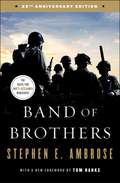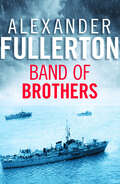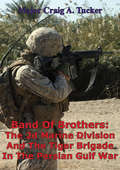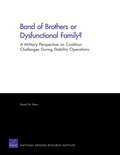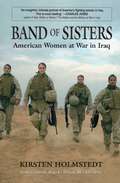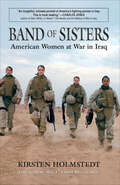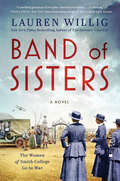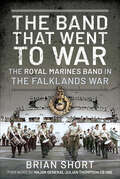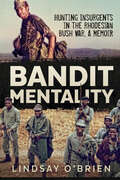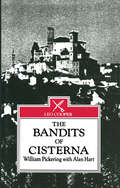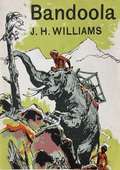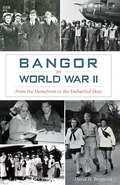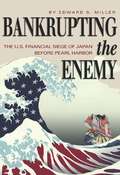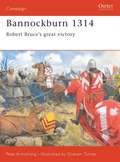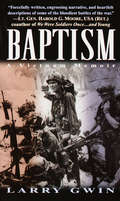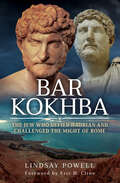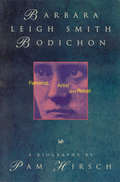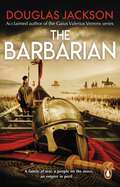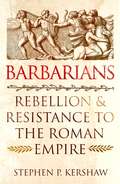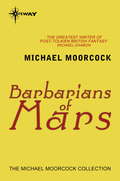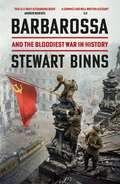- Table View
- List View
Band of Brothers: E Company, 506th Regiment, 101st Airborne from Normandy to Hitler's Eagle's Nest (American History Ser.)
by Stephen E. AmbroseStephen E. Ambrose&’s classic New York Times bestseller and inspiration for the acclaimed HBO series about Easy Company, the ordinary men who became the World War II&’s most extraordinary soldiers at the frontlines of the war's most critical moments. Featuring a foreword from Tom Hanks.They came together, citizen soldiers, in the summer of 1942, drawn to Airborne by the $50 monthly bonus and a desire to be better than the other guy. And at its peak—in Holland and the Ardennes—Easy Company was as good a rifle company as any in the world.From the rigorous training in Georgia in 1942 to the disbanding in 1945, Stephen E. Ambrose tells the story of this remarkable company. In combat, the reward for a job well done is the next tough assignment, and as they advanced through Europe, the men of Easy kept getting the tough assignments.They parachuted into France early D-Day morning and knocked out a battery of four 105 mm cannon looking down Utah Beach; they parachuted into Holland during the Arnhem campaign; they were the Battered Bastards of the Bastion of Bastogne, brought in to hold the line, although surrounded, in the Battle of the Bulge; and then they spearheaded the counteroffensive. Finally, they captured Hitler's Bavarian outpost, his Eagle's Nest at Berchtesgaden.They were rough-and-ready guys, battered by the Depression, mistrustful and suspicious. They drank too much French wine, looted too many German cameras and watches, and fought too often with other GIs. But in training and combat they learned selflessness and found the closest brotherhood they ever knew. They discovered that in war, men who loved life would give their lives for them. This is the story of the men who fought, of the martinet they hated who trained them well, and of the captain they loved who led them. E Company was a company of men who went hungry, froze, and died for each other, a company that took 150 percent casualties, a company where the Purple Heart was not a medal—it was a badge of office.
Band of Brothers
by Alexander FullertonDanger and bravery at sea from thriller-master Alexander Fullerton. It is early autumn 1943 and a German U-boat supply ship is sailing under heavy escort from Le Havre to the Atlantic. A mixed force of torpedo boats from Allied Coastal Forces is ordered to intercept and sink her. Navigator Ben Quarry has other worries. His girlfriend, Rosie, is set on returning to occupied France as an SOE agent, and his former mistress, now the wife of his CO, Bob Stack, has embarked on an affair with another officer. Ben&’s got to tell him. But in the heat of battle, survival is everything… A standalone naval thriller from a writer who was there, Band of Brothers will keep you gripped, and is perfect for fans of Max Hennessy and Alan Evans.
Band Of Brothers: The 2d Marine Division And The Tiger Brigade In The Persian Gulf War
by Major Craig A. TuckerThis monograph is an analysis of the impact of organizational culture on tactical joint warfare. The merger of the Tiger Brigade with 2d Marine Division during the Persian Gulf War serves as a laboratory for this analysis. The author researched after action reports, the papers of authors who have written on the Persian Gulf War and interviewed commanders and key staff of both units to determine whether differences in service culture reduced the combat effectiveness of either unit. This research is analyzed using a recently developed organizational theory that postulates that the human element is the most important and least understood factor in determining whether a merger between two organizations with different cultures will succeed or fail.This study concludes that the merger of the Tiger Brigade and 2d Marine Division was very successful. The key elements to that success were the relationship between the commanders, the effectiveness of liaison officers, the willingness of both units to learn from and understand the culture of the other and the amount of time available before actual combat to reduce cultural barriers.
Band of Brothers or Dysfunctional Family? A Military Perspective on Coalition Challenges during Stability Operations
by Russell W. GlennDuring stability operations, coalitions must incorporate participation by government agencies other than the military, the indigenous government, and its population more than is expected during conventional combat operations. This book investigates challenges confronting coalitions today and considers potential solutions that include questioning the conception of what constitutes a coalition in today's world.
Band of Sisters: American Women at War in Iraq
by Kirsten HolmstedtIn Iraq, the front lines are everywhere . . . and everywhere in Iraq, no matter what their job descriptions say, women in the U. S. military are fighting - over 155,000 of them. A critical and commercial success in hardcover, Band of Sisters presents a dozen groundbreaking and often heart-wrenching stories of American women in combat in Iraq, such as the US's first female pilot to be shot down and survive, the military's first black female pilot in combat, a young turret gunner defending convoys, and a nurse struggling to save lives, including her own.
Band of Sisters: American Women at War in Iraq
by Kirsten HolmstedtNow available in paperback. Winner of the 2007 American Authors Association Golden Quill Award. Winner of the 2007 Military Writers Society of America Founder's Award.
Band of Sisters: A Novel
by Lauren Willig"A crackling portrayal of everyday American heroines…A triumph." — Fiona Davis, New York Times bestselling author of The Lions of Fifth Avenue A group of young women from Smith College risk their lives in France at the height of World War I in this sweeping novel based on a true story—a skillful blend of Call the Midwife and The Alice Network—from New York Times bestselling author Lauren Willig.A scholarship girl from Brooklyn, Kate Moran thought she found a place among Smith’s Mayflower descendants, only to have her illusions dashed the summer after graduation. When charismatic alumna Betsy Rutherford delivers a rousing speech at the Smith College Club in April of 1917, looking for volunteers to help French civilians decimated by the German war machine, Kate is too busy earning her living to even think of taking up the call. But when her former best friend Emmeline Van Alden reaches out and begs her to take the place of a girl who had to drop out, Kate reluctantly agrees to join the new Smith College Relief Unit.Four months later, Kate and seventeen other Smithies, including two trailblazing female doctors, set sail for France. The volunteers are armed with money, supplies, and good intentions—all of which immediately go astray. The chateau that was to be their headquarters is a half-burnt ruin. The villagers they meet are in desperate straits: women and children huddling in damp cellars, their crops destroyed and their wells poisoned. Despite constant shelling from the Germans, French bureaucracy, and the threat of being ousted by the British army, the Smith volunteers bring welcome aid—and hope—to the region. But can they survive their own differences? As they cope with the hardships and terrors of the war, Kate and her colleagues find themselves navigating old rivalries and new betrayals which threaten the very existence of the Unit.With the Germans threatening to break through the lines, can the Smith Unit pull together and be truly a band of sisters?
The Band That Went to War: The Royal Marine Band in the Falklands War
by Brian ShortThe Royal Marines are renowned for their military skill and also for having one of the finest military bands in the world. These highly trained and talented musicians are equally at home parading at Buckingham Palace, playing at the Royal Albert Hall, or on the flight deck of an aircraft carrier in a foreign port. Why then when the Argentines invaded the Falklands in April 1982 did these superb musicians get involved in what became a serious and deadly military campaign? The answer is that, in addition to their musical expertise, the RM Band Service members are trained for military service and fully qualified in a multitude of military and medical skills, providing support to their comrades, the fighting commandos. The Band That Went to War is a graphic first-hand account of the Falklands War as it has never been told before. It describes the roles played by Royal Marine musicians in the conflict; unloading the wounded from helicopters, moving tons of stores and ammunition, burying their dead at sea and guarding and repatriating Argentine prisoners of war. These and other unseen tasks were achieved while still ready to provide morale boosting music to their commando brethren and other frontline troops. These men are not just musicians; they are Royal Marines.
Bandit Mentality: Hunting Insurgents in the Rhodesian Bush War, A Memoir
by Lindsay O’BrienA former officer of British South Africa&’s anti-terrorist unit recounts his experiences on the frontlines of the Rhodesian Bush war from 1976–1980. A native of New Zealand, Lindsay &‘Kiwi&’ O&’Brien served in the British South Africa Police Support Unit&’s anti-terrorist battalion. He traveled across the country as a section leader and a troop commander before joining the UANC political armies as trainer and advisor. The BSA Support Unit started poorly supplied and equipped, but the caliber of the men, mostly African, was second-to-none. Support Unit specialized in the &“grunt&” work inside Rhodesia with none of the flamboyant helicopter or cross-border raids carried out by the army. O&’Brien&’s war was primarily within selected tribal lands, seeking out and destroying Communist guerilla units in brisk close-range battles with little to no support. O&’Brien moved from the police to working with the initial UANC deployment in the Zambezi Valley where the poorly trained recruits had to learn fast or die. O&’Brien&’s account is a foreign-born perspective from a junior commander uninterested in promotion and the wrangling of upper command. He was decorated and wounded three times.
The Bandits of Cisterna
by Alan Hart William PickeringThe true story of Bill Pickering who was sent into Occupied Italy with a clandestine wireless set during World War II. He experienced many close encounters with the enemy and ended up fighting the Germans alongside the Italian Resistance Group, "The Bandits of Cisterna".
Bandoola
by Lt.-Col. J. H. Williams O.B.E.Those who have read Elephant Bill will remember the wartime exploits of that magnificent creature Bandoola. Bandoola and his oozie, Po Toke, are the principal characters in this delightful successor to a famous best-seller. But there are many others whom the author met and knew in the course of his work of extracting timber from the teak forests of Burma; Willie, who preferred wine to women; Millie, who could read the droppings of elephants like books; reckless Gerry Dawson and desperate Rasher; and--among the most intriguing--Molly Mia, the dog which Elephant Bill controlled by telepathy and which helped to select a wife for him."Bandoola touches a peak as high as that achieved by Elephant Bill. His latest book of elephant-lore in Burma is enthralling"--Daily Telegraph"If Elephant Bill is as good as Bandoola it must be a very good book indeed"--Howard Spring
Bang Bang, Shoot Shoot! Essays on Guns and Popular Culture (Second Edition)
by Murray Pomerance John SakerisThe essays in this book all relate to movies or television in which guns played a significant role. The director's use of guns is explored and the statement he is trying to make is often analyzed.
Bangor in World War II: From the Homefront to the Embattled Skies (Military)
by David H. BergquistAs the specter of a second world war grew, so did Bangor's strategic importance in eastern Maine. National Draft Day saw 3,157 local men register to serve, and the city built up its Dow Field as the nation braced for war. Nearly 6,000 servicemen and women called Dow their home base throughout World War II. Organizations like the local Soldiers Welfare Council and the USO welcomed the troops even as women stepped into roles vacated by enlisted men and worked tirelessly to keep up the community's patriotic spirit. Bangor and its world-class air base stood strong at home as its native sons fought valiantly on the warfront.
Bankrupting the Enemy
by Edward S. MillerAward-winning author Edward S. Miller contends in this new work that the United States forced Japan into international bankruptcy to deter its aggression. While researching newly declassified records of the Treasury and Federal Reserve, Miller, a retired chief financial executive of a Fortune 500 resources corporation, uncovered just how much money mattered. Washington experts confidently predicted that the war in China would bankrupt Japan, not knowing that the Japanese government had a huge cache of dollars fraudulently hidden in New York. Once discovered, Japan scrambled to extract the money. But, Miller explains, in July 1941 President Roosevelt invoked a long-forgotten clause of the Trading with the Enemy Act of 1917 to freeze Japan s dollars and forbade it to sell its hoard of gold to the U.S. Treasury, the only open gold market after 1939. Roosevelt s temporary gambit to bring Japan to its senses, not its knees, was thwarted, however, by opportunistic bureaucrats. Dean Acheson, his handpicked administrator, slyly maneuvered to deny Japan the dollars needed to buy oil and other resources for war and for economic survival.Miller's lucid writing and thorough understanding of the complexities of international finance enable readers unfamiliar with financial concepts and terminology to grasp his explanation of the impact of U.S. economic policies on Japan. His review of thirty-seven studies of Japan's resource deficiencies begs the question of why no U.S. agency calculated the impact of the freeze on Japan's overall economy. His analysis of a massive OSS-State Department study of prewar Japan clearly demonstrates that the deprivations facing the Japanese people were the country to remain in financial limbo buttressed its choice of war at Pearl Harbor. Such a well-documented study is certain to be recognized for its significant contributions to the historiography of the origins of the Pacific War.
Banning the Bang or the Bomb?
by Mordechai Melamud Paul Meerts I. William Zartman Mordechai Melamud Paul MeertsThe Comprehensive Test Ban Treaty (CTBT), negotiated between 1994 and 1996, is the latest development in the nuclear arms control regime. It continues to serve a vital role in preserving the privileged status of the nuclear weapons states and barring the way to proliferation. Banning the Bang or the Bomb? brings together a team of leading international experts who together analyse its negotiation as a model of regime creation, examining collective dynamics, the behaviour of individual countries, and the nature of specific issues. The book offers practical guidance and training for members of the Comprehensive Nuclear Test Ban Treaty Organization future inspectorate to help negotiate their way during an on-site inspection (OSI) in an inspected state. This is a valuable resource for researchers and professionals alike that turns an analysis of what has happened into a manual for what is about to happen.
Bannockburn 1314
by Graham Turner Peter ArmstrongOsprey's study of the Battle of Bannockburn, which was part of the First War of Scottish Independence (1296-1328) and the climax of the career of King Robert the Bruce. In 1307 King Edward I of England, 'The Hammer of the Scots' and nemesis of William Wallace, died and his son, Edward II, was not from the same mould. Idle and apathetic, he allowed the Scots the chance to recover from the grievous punishment inflicted upon them. By 1314 Bruce had captured every major English-held castle bar Stirling and Edward II took an army north to subdue the Scots. Pete Armstrong's account of this pivotal campaign culminates at the decisive battle of Bannockburn that finally won Scotland her independence.
Baptism
by Larry Gwin"The 2nd Battalion of the 7th Cavalry had the dubious distinction of being the unit that had fought the biggest battle of the war to date, and had suffered the worst casualties. We and the 1st Battalion."A Yale graduate who volunteered to serve his country, Larry Gwin was only twenty-three years old when he arrived in Vietnam in 1965. After a brief stint in the Delta, Gwin was reassigned to the 1st Cavalry Division (Airmobile) in An Khe. There, in the hotly contested Central Highlands, he served almost nine months as executive officer for Alpha Company, 2/7, fighting against crack NVA troops in some of the war's most horrific battles.The bloodiest conflict of all began November 12, 1965, after 2nd Battalion was flown into the Ia Drang Valley west of Pleiku. Acting as point, Alpha Company spearheaded the battalion's march to landing zone Albany for pickup, not knowing they were walking into the killing zone of an NVA ambush that would cost them 10 percent casualties.Gwin spares no one, including himself, in his gut-wrenching account of the agony of war. Through the stench of death and the acrid smell of napalm, he chronicles the Vietnam War in all its nightmarish horror.From the Paperback edition.
Baptism: A Vietnam Memoir
by Larry Gwin"The 2nd Battalion of the 7th Cavalry had the dubious distinction of being the unit that had fought the biggest battle of the war to date, and had suffered the worst casualties. We and the 1st Battalion." A Yale graduate who volunteered to serve his country, Larry Gwin was only twenty-three years old when he arrived in Vietnam in 1965. After a brief stint in the Delta, Gwin was reassigned to the 1st Cavalry Division (Airmobile) in An Khe. There, in the hotly contested Central Highlands, he served almost nine months as executive officer for Alpha Company, 2/7, fighting against crack NVA troops in some of the war's most horrific battles. The bloodiest conflict of all began November 12, 1965, after 2nd Battalion was flown into the Ia Drang Valley west of Pleiku. Acting as point, Alpha Company spearheaded the battalion's march to landing zone Albany for pickup, not knowing they were walking into the killing zone of an NVA ambush that would cost them 10 percent casualties. Gwin spares no one, including himself, in his gut-wrenching account of the agony of war. Through the stench of death and the acrid smell of napalm, he chronicles the Vietnam War in all its nightmarish horror.
Bar Kokhba: The Jew Who Defied Hadrian and Challenged the Might of Rome (Campaign Ser. #310)
by Lindsay PowellBAR KOKHBA is the search for the truth of the epic struggle between two strong-willed leaders over who would rule a nation. One was Hadrian, the cosmopolitan ruler of the vast Roman Empire, then at its zenith, who some regarded as divine; the other was Shim’on, a Jewish military leader in a district of a minor province, who some believed to be the ‘King Messiah’. It is also the tale of the clash of two ancient cultures. One was the conqueror, seeking to maintain control of its hard-won dominion; the other was the conquered, seeking to break free and establish a new nation: Israel. During the ensuing conflict – the ‘Second Jewish War’ – the highly motivated Jewish militia sorely tested the highly trained professional Roman army. The rebels withstood the Roman onslaught for three-and-a-half years (AD 132 - 136). They established an independent nation with its own administration, headed by Shim’on as its president. The outcome of that David and Goliath contest was of great consequence, both for the people of Judaea and for Judaism itself. So, who was this insurgent Shim’on known today as ‘Bar Kokhba’? How did Hadrian, the Roman emperor who built the famous Wall in northern Britain, respond to the challenger? And how, in later ages, did this rebel with a cause become a hero for the Jews in the Diaspora longing for the foundation of a new Israel in modern times? This book describes the author’s personal journey across three continents to establish the facts. BAR KOKHBA is lucidly written by the author of the mould-breaking Augustus at War and the acclaimed biographies Germanicus and Marcus Agrippa. Drawing on archaeology, art, coins, inscriptions, militaria, as well as secular and religious documents, Lindsay Powell presents a fascinating account of the people and events at a crucial time in world history.
Barbara Leigh Smith Bodichon: Feminist, Artist and Rebel
by Pam HirschBarbara Leigh Smith Bodichon was the most unconventional and influential leader of the Victorian women's movement. Enormously talented, energetic and original, she was a feminist, law-reformer, painter, journalist, the close friend of George Eliot and a cousin of Florence Nightingale. As a painter, Barbara is now recognised as a vital figure among Pre-Raphaelite women artists. As a feminist she led four great campaigns: for married women's legal status, for the right to work, the right to vote and to education. Making brilliant use of unpublished journals and letters, Pam Hirsch has written a biography that is as lively and powerful as its subject, recreating the woman in all her moods, and placing her firmly in the context of women's struggle for equality.
The Barbarian
by Douglas JacksonAD 406. Abandoned by friends and hounded by enemies, Roman cavalry commander Marcus Flavius Victor and a small band of loyal warriors know that the time has come to leave an increasingly fractured Britannia.Their journey takes them across the bleak, pirate-infested seas of the Mare Germanicum to Saxonia and on into the dark heart of barbarism. It seems the Britons' only salvation lies with an old comrade, General Stilicho - based far to the east but still within the sanctuary of the Empire. But the general has troubles of his own: his influence with the Emperor Honorius is waning, and a great warrior people are on the march - for Radagaisus, king of the Ostrogoths, has promised his subjects all the riches of Italia, and they will leave a sea of Roman bones in their wake.But as Marcus and his companions battle their way towards what they hope will a safe haven of sorts, they stumble across a secret which could decide the fate of the Empire. But who can they really trust, and can Marcus reach Stilicho in time - because his every step is dogged by a son who wants him dead...Set during the desperate twilight years of Rome's once all-powerful empire, The Barbarian is the action-packed and thrillingly authentic new historical novel from one of the genre's very best.
Barbarians: Rebellion and Resistance to the Roman Empire
by Dr Stephen P. KershawA fresh new look at the Roman Empire, from the point of view of those regarded by the Romans as 'barbarians'. Kershaw builds a narrative around the lives, personalities, successes and failures both of the key opponents of Rome's rise and dominance, and of the those who ultimately brought the empire down.'And now what will become of us without barbarians?Those people were a sort of solution.' 'Waiting for the Barbarians' C. P. CavafyHistory is written by the victors, and Rome had some very eloquent historians. Those the Romans regarded as barbarians left few records of their own, but they had a tremendous impact on the Roman imagination. Resisting from outside Rome's borders or rebelling from within, they emerge vividly in Rome's historical tradition, and left a significant footprint in archaeology.Rome's history, as written by the Romans, follows a remarkable trajectory from its origins as a tiny village of refugees from a conflict zone to a dominant superpower, before being transformed into the medieval and Byzantine worlds. But throughout this history, Rome faced significant resistance and rebellion from peoples whom it regarded as barbarians. Gibbon saw the Roman Empire as one of the highest points of human achievement destroyed by barbarian invaders: Ostrogoths, Visigoths, Goths, Vandals, Huns, Picts and Scots. To others, as Rome was ravaged, new life was infused into an expiring Italy. Gibbon's 'decline and fall' has been reappraised as transformation, through religious and cultural revolution. Based both on ancient historical writings and modern archaeological research, this new history takes a fresh look at the Roman Empire, through the personalities and lives of key opponents of Rome's rise, dominance and fall - or transformation. These include: Brennus, the Gaul who sacked Rome; the Plebs, those barbarous insiders and internal resistors; Hannibal; Viriathus, the Iberian shepherd and skilled guerilla; Jugurtha and the struggle to free Africa; the Germanic threat from the Cimbri and the Teutones; Spartacus, the gladiator; Vercingetorix and rebellion in Gaul; Cleopatra; Boudicca, the Queen of the Iceni and the scourge of Rome; the Great Jewish Revolt; Alaric the Goth and the Sack of Rome; Attila the Hun, 'Born to Shake the Nations'; and the Vandals and the fall of Rome.
Barbarians of Mars
by Michael MoorcockMichael Moorcock's Eternal Champion returns in the form of Michael Kane, a brilliant Earthman stranded on the treacherous deserts of Ancient Mars! In this sweeping, epic sword-and-planet adventure in the tradition of Edgar Rice Burroughs, Kane and his blue giant companion Hool Haji must travel to the far reaches of the Red Planet to halt the hideous Green Death, an unstoppable disease that rots the mind as well as the body. From gorgeous Karnala, City of Green Mists, to the empty streets of tainted Cend-Amrid to the forgotten weird-science laboratories of the lost, highly advanced Yaksha culture, Masters of the Pit promises stunning locales, disgusting Martian creatures, and relentless action from the Nebula and World Fantasy Award-winning creator of Elric of Melniboné! Enjoy book three of the Warrior of Mars series in ebook for the first time!
The Barbarization of Warfare
by George KassimerisThe images from Abu Ghraib prison in Baghdad have been a grim reminder of warfare's undiminished capacity for brutality and indiscriminate excess. What happened in Abu Ghraib has happened before: the World War II, and more recent wars and insurgencies in Algeria, Congo, Angola, Vietnam, Bosnia, Kosovo, Chechnya, and many others, all bear witness to the ever-present human capacity to commit barbaric acts if circumstances allow.What drives people to mistreat, humiliate, and torment others? In an age when real time war, violence, and torture are becoming addictive forms of entertainment, it is now more critical than ever to deepen our understanding of the extraordinary distortions of the human psyche and spirit that occur in wartime. Eight distinguished scholars explore, in this first collective effort, the effects of the barbarization of warfare on our cultures and societies.Contributors: Joanna Bourke, Niall Ferguson, Jay Winter, Richard Overy, David Anderson, Hew Strachan, Paul Rogers, Kathleen Taylor, Marilyn Young, Paul Rogers, Anthony Dworkin, Amir Weiner, Mary Habeck, and David Simpson.
Barbarossa: And the Bloodiest War in History
by Stewart BinnsDrawing on remarkable and never-before-seen material, the extraordinary story of one of the most horrific and devastating encounters of the Second World War.On June 22nd, 1941 the largest military invasion in human history was launched - an attack on the Soviet Union by almost four million men of Nazi Germany's brutal war machine.Operation Barbarossa led to the bloodiest military campaign mankind has ever known. The statistics of death and destruction are almost impossible to believe. The cruelty, suffering and destitution it wrought are unimaginable . . . over forty million people lost their lives.Yet, the real story of the Eastern Front is still not truly understood outside of Germany and Eastern Europe. Little is known of those who suffered in the horror of Hitler's 'War of Annihilation' - the soldiers and civilians of Eastern Europe who fought and died trying to save their homelands and their loved ones.In Barbarossa, Stewart Binns tells the story of how they lived and survived, and how, once the tide had turned, they exacted an appalling revenge on the Nazi aggressors. This is the story of the bloodiest war in history.'This is a truly astounding book, packed with searing hitherto-unpublished testimony about what it was like to endure, and ultimately defeat, the most formidable invasion in the history of Mankind.' - Andrew Roberts, author of CHURCHILL: WALKING WITH DESTINY'A masterful narrative, deeply enriched by extraordinary research and a profound analysis of the soul of Russia.' - Nick Hewer
